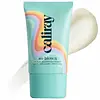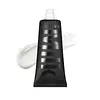What's inside
What's inside
 Key Ingredients
Key Ingredients

 Benefits
Benefits

 Concerns
Concerns

 Ingredients Side-by-side
Ingredients Side-by-side

Caprylyl Methicone
Skin ConditioningWater
Skin ConditioningPEG-12 Dimethicone/PPG-20 Crosspolymer
Disiloxane
Skin ConditioningPolysilicone-11
Isodecyl Neopentanoate
EmollientTripeptide-29
Skin ConditioningAdipic Acid/Neopentyl Glycol Crosspolymer
Hdi/Trimethylol Hexyllactone Crosspolymer
Niacinamide
SmoothingCaprylic/Capric Triglyceride
MaskingTocopherol
AntioxidantTocopheryl Acetate
AntioxidantCamellia Oleifera Seed Oil
Skin ConditioningSodium Acrylate/Sodium Acryloyldimethyl Taurate Copolymer
Emulsion StabilisingIsohexadecane
EmollientPolysorbate 80
EmulsifyingLaureth-12
EmulsifyingSorbitan Oleate
EmulsifyingLeuconostoc/Radish Root Ferment Filtrate
AntimicrobialSilica
AbrasivePistacia Lentiscus Gum
MaskingHydrogenated Lecithin
EmulsifyingPhenethyl Alcohol
MaskingPhenoxyethanol
PreservativeEthylhexylglycerin
Skin ConditioningCitrus Aurantium Dulcis Oil
MaskingCitronellol
PerfumingGeraniol
PerfumingFarnesol
PerfumingLimonene
PerfumingLinalool
PerfumingCitral
PerfumingCaprylyl Methicone, Water, PEG-12 Dimethicone/PPG-20 Crosspolymer, Disiloxane, Polysilicone-11, Isodecyl Neopentanoate, Tripeptide-29, Adipic Acid/Neopentyl Glycol Crosspolymer, Hdi/Trimethylol Hexyllactone Crosspolymer, Niacinamide, Caprylic/Capric Triglyceride, Tocopherol, Tocopheryl Acetate, Camellia Oleifera Seed Oil, Sodium Acrylate/Sodium Acryloyldimethyl Taurate Copolymer, Isohexadecane, Polysorbate 80, Laureth-12, Sorbitan Oleate, Leuconostoc/Radish Root Ferment Filtrate, Silica, Pistacia Lentiscus Gum, Hydrogenated Lecithin, Phenethyl Alcohol, Phenoxyethanol, Ethylhexylglycerin, Citrus Aurantium Dulcis Oil, Citronellol, Geraniol, Farnesol, Limonene, Linalool, Citral
Water
Skin ConditioningSilica
AbrasivePropanediol
SolventNylon-11
Pentylene Glycol
Skin ConditioningNiacinamide
SmoothingPolyglyceryl-10 Diisostearate
EmulsifyingDicaprylyl Ether
EmollientCorn Starch Modified
AbsorbentBakuchiol
AntimicrobialParfum
MaskingHamamelis Virginiana Water
AstringentButyrospermum Parkii Butter Unsaponifiables
Skin ConditioningLens Esculenta Seed Extract
Skin ProtectingShorea Robusta Seed Butter
EmollientCoffea Arabica Seed Oil
MaskingGlycine Soja Oil
EmollientTocopherol
AntioxidantMoonstone Powder
Skin ConditioningGlyceryl Undecylenate
EmollientEthyl Stearate
EmollientEthyl Palmitate
EmollientEthyl Oleate
EmollientEthyl Linoleate
EmollientAcrylates/Beheneth-25 Methacrylate Copolymer
Ethyl Macadamiate
Skin ConditioningMalic Acid
BufferingSodium Carbomer
Emulsion StabilisingSaccharide Isomerate
HumectantSodium Hyaluronate
HumectantSodium Hydroxide
BufferingTrisodium Ethylenediamine Disuccinate
Ethylhexylglycerin
Skin ConditioningGlyceryl Caprylate
EmollientPhenoxyethanol
PreservativeLinalool
PerfumingWater, Silica, Propanediol, Nylon-11, Pentylene Glycol, Niacinamide, Polyglyceryl-10 Diisostearate, Dicaprylyl Ether, Corn Starch Modified, Bakuchiol, Parfum, Hamamelis Virginiana Water, Butyrospermum Parkii Butter Unsaponifiables, Lens Esculenta Seed Extract, Shorea Robusta Seed Butter, Coffea Arabica Seed Oil, Glycine Soja Oil, Tocopherol, Moonstone Powder, Glyceryl Undecylenate, Ethyl Stearate, Ethyl Palmitate, Ethyl Oleate, Ethyl Linoleate, Acrylates/Beheneth-25 Methacrylate Copolymer, Ethyl Macadamiate, Malic Acid, Sodium Carbomer, Saccharide Isomerate, Sodium Hyaluronate, Sodium Hydroxide, Trisodium Ethylenediamine Disuccinate, Ethylhexylglycerin, Glyceryl Caprylate, Phenoxyethanol, Linalool
Alternatives
Ingredients Explained
These ingredients are found in both products.
Ingredients higher up in an ingredient list are typically present in a larger amount.
Ethylhexylglycerin (we can't pronounce this either) is commonly used as a preservative and skin softener. It is derived from glyceryl.
You might see Ethylhexylglycerin often paired with other preservatives such as phenoxyethanol. Ethylhexylglycerin has been found to increase the effectiveness of these other preservatives.
Linalool is a fragrance and helps add scent to products. It's derived from common plants such as cinnamon, mint, citrus, and lavender.
Like Limonene, this ingredient oxidizes when exposed to air. Oxidized linalool can cause allergies and skin sensitivity.
This ingredient has a scent that is floral, spicy tropical, and citrus-like.
Learn more about LinaloolNiacinamide is a multitasking form of vitamin B3 that strengthens the skin barrier, reduces pores and dark spots, regulates oil, and improves signs of aging.
And the best part? It's gentle and well-tolerated by most skin types, including sensitive and reactive skin.
You might have heard of "niacin flush", or the reddening of skin that causes itchiness. Niacinamide has not been found to cause this.
In very rare cases, some individuals may not be able to tolerate niacinamide at all or experience an allergic reaction to it.
If you are experiencing flaking, irritation, and dryness with this ingredient, be sure to double check all your products as this ingredient can be found in all categories of skincare.
When incorporating niacinamide into your routine, look out for concentration amounts. Typically, 5% niacinamide provides benefits such as fading dark spots. However, if you have sensitive skin, it is better to begin with a smaller concentration.
When you apply niacinamide to your skin, your body converts it into nicotinamide adenine dinucleotide (NAD). NAD is an essential coenzyme that is already found in your cells as "fuel" and powers countless biological processes.
In your skin, NAD helps repair cell damage, produce new healthy cells, support collagen production, strengthen the skin barrier, and fight environmental stressors (like UV and pollution).
Our natural NAD levels start to decline with age, leading to slower skin repair, visible aging, and a weaker skin barrier. By providing your skin niacinamide, you're recharging your skin's NAD levels. This leads to stronger, healthier, and younger looking skin.
Another name for vitamin B3 is nicotinamide. This vitamin is water-soluble and our bodies don't store it. We obtain Vitamin B3 from either food or skincare. Meat, fish, wheat, yeast, and leafy greens contain vitamin B3.
The type of niacinamide used in skincare is synthetically created.
Learn more about NiacinamidePhenoxyethanol is a preservative that has germicide, antimicrobial, and aromatic properties. Studies show that phenoxyethanol can prevent microbial growth. By itself, it has a scent that is similar to that of a rose.
It's often used in formulations along with Caprylyl Glycol to preserve the shelf life of products.
Silica, also known as silicon dioxide, is a naturally occurring mineral. It is used as a fine, spherical, and porous powder in cosmetics.
Though it has exfoliant properties, the function of silica varies depending on the product.
The unique structure of silica enhances the spreadability and adds smoothness, making it a great texture enhancer.
It is also used as an active carrier, emulsifier, and mattifier due to its ability to absorb excess oil.
In some products, tiny microneedles called spicules are made from silica or hydrolyzed sponge. When you rub them in, they lightly polish away dead skin layers and enhance the penetration of active ingredients.
Learn more about SilicaTocopherol (also known as Vitamin E) is a common antioxidant used to help protect the skin from free-radicals and strengthen the skin barrier. It's also fat soluble - this means our skin is great at absorbing it.
Vitamin E also helps keep your natural skin lipids healthy. Your lipid skin barrier naturally consists of lipids, ceramides, and fatty acids. Vitamin E offers extra protection for your skin’s lipid barrier, keeping your skin healthy and nourished.
Another benefit is a bit of UV protection. Vitamin E helps reduce the damage caused by UVB rays. (It should not replace your sunscreen). Combining it with Vitamin C can decrease sunburned cells and hyperpigmentation after UV exposure.
You might have noticed Vitamin E + C often paired together. This is because it is great at stabilizing Vitamin C. Using the two together helps increase the effectiveness of both ingredients.
There are often claims that Vitamin E can reduce/prevent scarring, but these claims haven't been confirmed by scientific research.
Learn more about TocopherolWater. It's the most common cosmetic ingredient of all. You'll usually see it at the top of ingredient lists, meaning that it makes up the largest part of the product.
So why is it so popular? Water most often acts as a solvent - this means that it helps dissolve other ingredients into the formulation.
You'll also recognize water as that liquid we all need to stay alive. If you see this, drink a glass of water. Stay hydrated!
Learn more about Water